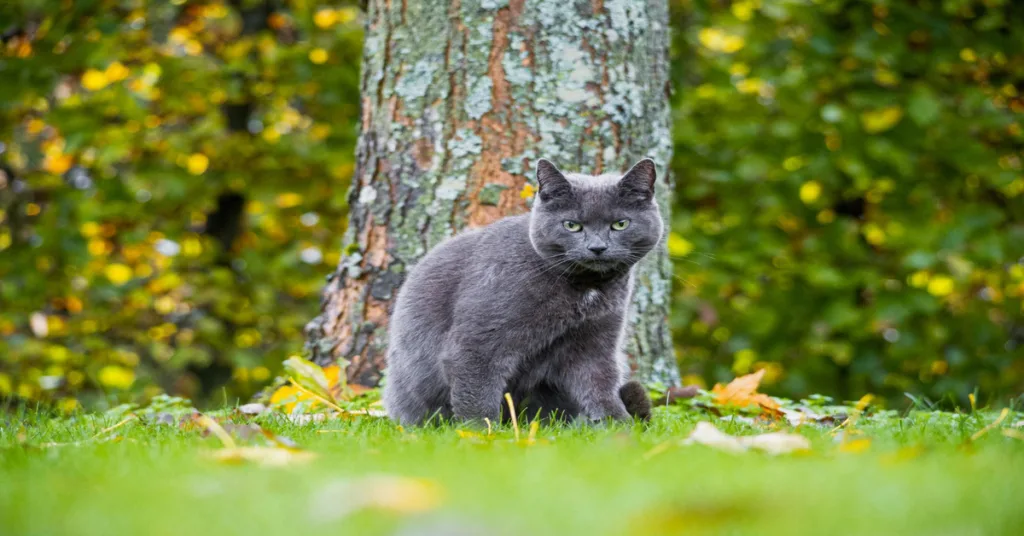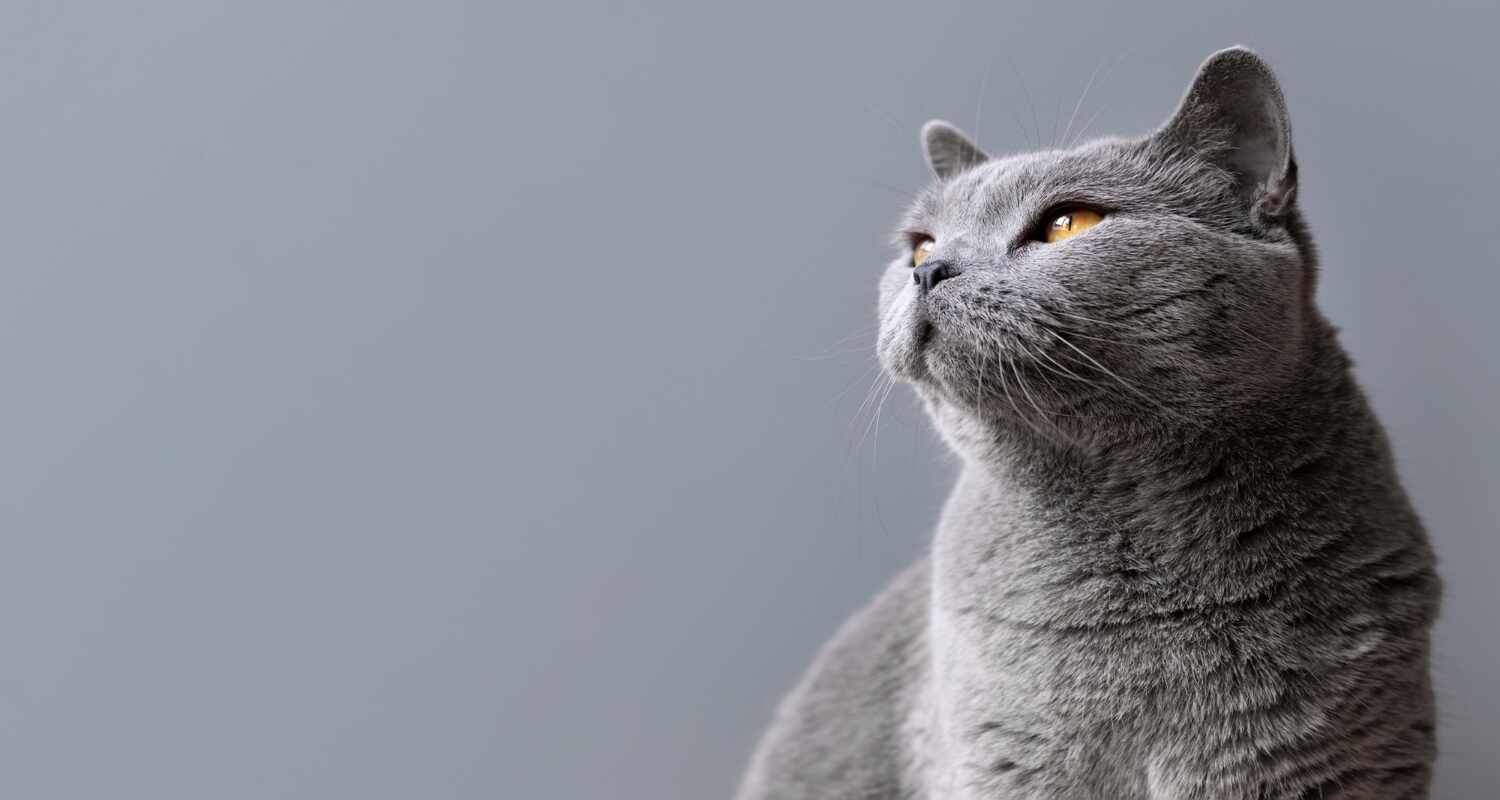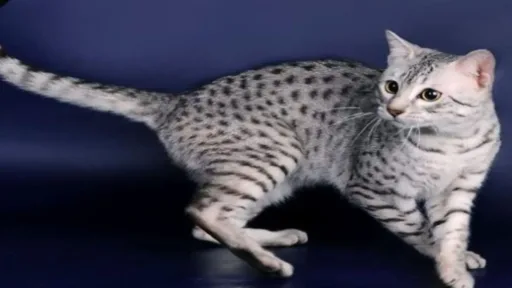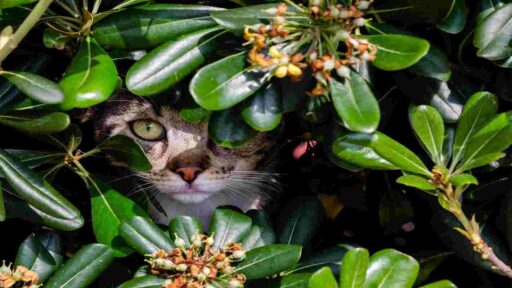The Russian Blue Cat possesses a distinctive breed profile, showcasing a striking appearance with a short, dense, and plush silver-blue coat that shimmers in the light.
These cats also boast mesmerizing vivid green eyes, which beautifully contrast their coat. Renowned for their gentle and affectionate nature, Russian Blues are intelligent, often forming strong bonds with their human companions.
Reserved with strangers, Russian Blues swiftly bond with trusted individuals, becoming affectionate companions for households seeking an amiable feline.
Characteristics of Russian Blue Cat

Several distinctive characteristics are known about Russian Blue cats:
- Coat: They sport a dense, short, and plush silver-blue coat that has a shimmering quality. The coat is double-layered, giving it a luxurious feel and a unique sheen.
- Eyes: Their striking almond-shaped, vivid green eyes are one of their most captivating features, contrasting beautifully with their silver-blue coat.
- Temperament: Russian Blues are intelligent, gentle, and affectionate cats. They’re known for forming strong bonds with their human companions and are often loyal and devoted to their families.
- Personality: They tend to be reserved around strangers but warm up quickly to familiar faces. These cats are playful, yet they maintain a calm and composed demeanor.
- Adaptability: They typically adjust well to various environments, making them suitable for different households. They’re known for their adaptability to change and tend to get along well with children and other pets.
- Grooming: Due to their short coats, Russian Blues require minimal grooming, needing only occasional brushing to keep their coat in top condition
Origins
The Russian Blue’s origins are somewhat shrouded in mystery and legend.
They are believed to have originated from the Archangel Isles in northern Russia, earning the name “Archangel Cat” due to their supposed arrival from the port of Arkhangelsk. Sailors and traders might have brought these cats to Europe and other parts of the world in the 1860s, where they quickly garnered attention for their stunning appearance and gentle demeanor.
The breed’s initial characteristics included a dense, plush, silver-blue coat and vibrant green eyes, distinguishing them from other cats of that era. In cat shows in the UK, these cats gained popularity and eventually received the name Russian Blue cats, highlighting their refined features and elegant demeanor.
Throughout history, Russian Blues were selectively bred to maintain their signature traits: the dense double coat with a distinct blue hue and the captivating green eyes. Their graceful build, intelligence, and affectionate nature further solidified their reputation as a sought-after breed among cat enthusiasts.
History
The history of the Russian Blue cat is rich and intriguing. Originating from Russia, people initially called these cats “Archangel Cats” or “Foreign Blues” because of their presumed arrival from the Archangel Isles. Their presence in Europe dates back to the 1860s when they captured attention for their stunning silver-blue coats and captivating green eyes.
In the UK, they gained early popularity and featured in cat exhibitions, ultimately earning the name “Russian Blue.” People admired these cats for their elegance, intelligence, and gentle disposition, making them prized pets among households.
Personality and tempalerement
The Russian Blue cat exhibits a distinctive personality and temperament:
- Gentle Demeanor: They are typically gentle, with a calm and composed disposition. Their behavior often reflects an air of sophistication and elegance.
- Affectionate Nature: Despite their initial reservedness with strangers, Russian Blues form deep attachments to their human family members. They’re affectionate and enjoy close bonds, often seeking out their favorite people for companionship.
- Intelligence: These cats are notably intelligent and curious. They enjoy interactive play and mental stimulation, thriving on challenges that engage their sharp minds.
- Playfulness: While they maintain a poised demeanor, Russian Blues are playful cats. They enjoy interactive toys and games that allow them to showcase their agility and intelligence.
- Reserved with Strangers: They tend to be cautious around unfamiliar people but warm up once they feel comfortable in the presence of trusted individuals.
- Adaptability: Russian Blues can adapt well to various environments and living situations, making them suitable for different types of households.

Growth and maturity
Russian Blue Cat typically follows a similar growth and maturity pattern to other domestic cat breeds.
- Kitten Stage (0-6 Months): During this phase, Russian Blue kittens grow rapidly. They’re playful, curious, and full of energy. Proper nutrition and socialization are essential for their development during this stage.
- Adolescence (6-12 Months): As they approach one year of age, Russian Blue cats start to reach their adult size. They may still exhibit kitten-like behavior but are gradually transitioning into adult behaviors.
- Adulthood (1-2 Years): By the age of one, Russian Blues are considered adults. They reach their full size, and their personality traits and temperament stabilize. They’re active, and playful, and often maintain their affectionate nature throughout adulthood.
- Maturity (2+ Years): Beyond two years, Russian Blue cats are fully matured. They settle into their established routines and behaviors. Their energy levels might stabilize, and they become more predictable in their habits and preferences.
Their growth rate and maturity can vary slightly from cat to cat, but generally, Russian Blues mature into elegant, graceful adults with their distinctive characteristics fully developed
Care
Caring for a Russian Blue Cat involves a few specific considerations:
- Grooming: Their short coat requires minimal grooming, but regular brushing helps reduce shedding and keeps their fur in good condition. A soft brush once or twice a week should suffice.
- Nutrition: Provide a balanced diet with high-quality cat food appropriate for their age and activity level. Ensure access to fresh water at all times.
- Play and Exercise: Russian Blues are active and enjoy playtime. Engage them with interactive toys and provide opportunities for exercise to keep them mentally stimulated and physically fit.
- Litter Box: Keep their litter box clean and easily accessible. They prefer a clean environment and may become stressed if their litter box isn’t well-maintained.
- Veterinary Care: Regular vet check-ups are important for their health. Stay up-to-date with vaccinations, flea and tick prevention, and any necessary medical treatments.
- Affection and Attention: Russian Blues are affectionate cats that thrive on companionship. Spend quality time with them, offering cuddles and attention, as they enjoy forming close bonds with their human family members.
By paying attention to these aspects of care, you can ensure your Russian Blue remains healthy, happy, and content in their home environment
Comparisons to other breeds
Russian Blue cats have unique characteristics that set them apart from other breeds, but comparisons can be made with similar traits found in some other breeds:
- Similarities with Chartreux: Both the Russian Blue and Chartreux breeds share some resemblances, such as their blue-gray coat. However, the Chartreux tends to have a woollier texture to its coat compared to the Russian Blue’s more plush, sleek fur.
- Resemblance to British Shorthair: The British Shorthair bears some resemblance to the Russian Blue in terms of its plush coats and sturdy build. However, the British Shorthair tends to have a broader face and a more rounded body compared to the sleeker, more angular appearance of the Russian Blue.
- Contrast with Siamese: In contrast to the Russian Blue’s reserved nature, Siamese cats are known for their talkative and social personalities. Siamese cats also have a striking appearance with their pointed coat pattern and vivid blue almond-shaped eyes, which differ from the Russian Blue’s silver-blue coat and green eyes.
- Differences from Maine Coon: The Maine Coon breed is significantly larger and more robust than the Russian Blue. While both breeds can be affectionate, the Maine Coon tends to have a more outgoing and sociable personality compared to the reserved nature often seen in Russian Blues.
Each breed has its unique characteristics and personality traits, and while some similarities may exist, each cat is an individual with its distinct personality, regardless of breed.
FaQs
Why is the Russian Blue Cat so special?
Several reasons deem Russian Blue cats special, primarily due to their striking appearance characterized by a unique silver-blue coat and vibrant green eyes.
Apart from their beauty, people often describe them as intelligent, affectionate, and loyal companions. Their gentle nature and tendency to form strong bonds with their human families make them stand out among cat breeds. Additionally, they’re typically good with children and other pets, adding to their appeal as wonderful household companions.
Is Russian Blue Cat expensive?
Compared to some other cat breeds, the Russian Blue cat can be relatively expensive. The cost can vary based on various factors including pedigree, lineage, breeder reputation, and location. Typically, purebred Russian Blue kittens from reputable breeders may have a higher price due to their desirable traits, such as specific coat color, lineage, and health screenings. Adoption from shelters or rescues might be more budget-friendly, offering the chance to provide a loving home for a Russian Blue cat at a lower cost.
Is the Russian Blue Cat friendly?
People generally know Russian Blue cats for their friendly and affectionate nature. They often form strong bonds with their human companions and enjoy spending time with their families. They can be gentle, loving, and loyal, making them great pets for households seeking a friendly feline companion.
Is a Russian Blue Cat rare?
Russian Blue cats are not necessarily rare, but they are not as common as some other breeds. Their distinctive appearance, characterized by their silver-blue coat and bright green eyes, contributes to their unique appeal. Although they might not reach the prevalence of more popular breeds like Persians or Siamese, people seek out Russian Blues for their beauty, gentle temperament, and loyalty, which can render them a bit less common in some areas.




